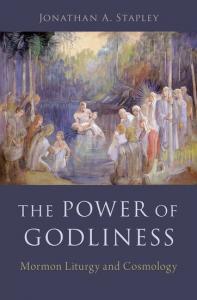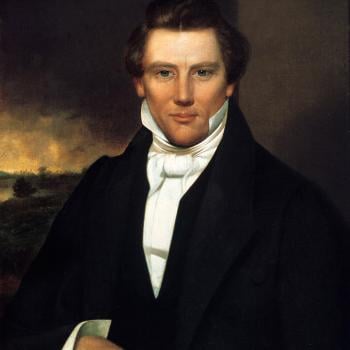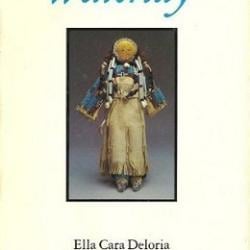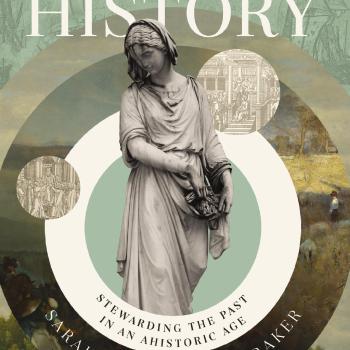“Mary A. young admited into the hiest orderer Preasthood,” Brigham Young wrote in his diary on November 1, 1843. The entry has long intrigued me, in part because Young apparently what he wrote above that sentence and because he married a plural wife named Harriet Cook on the same date.
What did it mean for Mary Ann, Brigham Young’s only wife from 1834 until he married plurally in 1842, to be admitted into the highest order of priesthood? It certainly did not mean that she gained access to particular ecclesiastical offices, nor did it mean that she gained the authority to preside over particular rituals. Most simply, Brigham Young recorded his wife’s admission into the “Anointed Quorum,” those men and women who participated in the washings, anointings, and covenants of the endowment ceremony.
That Mary Ann Young was admitted into the highest order of priesthood does not make much sense within the contemporary LDS understanding of priesthood. Brigham Young’s comment, however, does make a great deal of sense in the context of Jonathan Stapley’s new book The Power of Godliness (2018, Oxford University Press).
Stapley is one of the many wonders of the world of Mormon Studies. The book’s jacket identifies him as “the Chief Technological Officer for a bio-renewables company” and “an award-winning historian.” Not bad. Full-time historians and scholars of religion would be hard pressed to emulate this book’s many virtues: its chronological breadth, its use of an astonishing array of primary sources, and its engagement with the theoretical study of religious ritual.
“Liturgy” is the subject matter of The Power of Godliness. Stapley defines liturgy as a church’s “ritualized system of worship,” and Mormonism brims with liturgy: temple ordinances, baby blessings, and anointing for healing. Those familiar with his work (especially several essays co-authored with Kris Wright), and that of other scholars, might know that whereas nineteenth-century Mormon women often performed rituals of healing, later generations of church leaders restricted the practice to male priesthood holders. They might know that under Brigham Young’s leadership, the church introduced the ordinance of adoption — “the practice of sealing biologically unrelated people in child-to-parent relationships.” Wilford Woodruff eventually discontinued the practice.
What Stapley does brilliantly in The Power of Godliness is to tie these many changes in Mormon liturgy together within an explanatory framework centered around the shifting meaning of priesthood within the LDS Church. As he notes at the outset, “‘Priesthood’ ‘is a word with dramatically shifting definitions throughout Mormon history, and it is also an area of intense social interest today” because of the Ordain Women movement and the church’s suppression of it.
Throughout the volume, Stapley keeps two meanings of “priesthood” in mind: ecclesiastical and cosmological. Here is a brief summary:
In the first years of the church, ordination by the laying on of hands was a ritual that authorized priesthood officers to govern the church, evangelize, and administer church liturgies [such as baptism]… The expanded temple liturgy and cosmology Smith revealed in the early 1840s entailed the creation of a material heaven, comprising eternal sealed relationships between believers, both male and female. Those who participated in these relationships called this material heaven the priesthood. This expanded preisthood was not ecclesiastical in nature; instead, it constituted the very structure of the cosmos. With time, Latter-day Saints moved away from the use of priesthood language to describe the temple cosmology, and at the turn of the twentieth century … they began to describe a new priesthood cosmology based on the expansion of priesthood ecclesiology.
Mary Ann Young was admitted into this “material heaven” or “cosmological” priesthood that was closely connected to both the endowment and to plural marriage. Adoption was a new way of stitching together the human family into the order of heaven. Over time, as the church set aside both adoption and polygamy, it did not abandon these ideas of connecting the entire human family, but it elevated the connections between priesthood, male ecclesiastical authority, and liturgy. The decline of the idea of “cosmological priesthood” left the place of women within Mormon liturgy ill-defined, with the leadership of women essential for certain rituals but excluded in many other cases.
The “changing lexical terrain” of priesthood enables Stapley to offer clear analysis on a host of subjects. The “priesthood ban,” for instance, was not just or even primarily that black men could not hold ecclesiastical offices or be ordained into the Aaronic and Melchizedek priesthoods. It was that men, women, and children of African descent were excluded from the cosmological priesthood, the family of heaven.
Once presided over by bishops, baby blessings became the prerogative of fathers (if the fathers were priesthood holders). “Whereas the cosmological priesthood of Nauvoo,” writes Stapley, “had created an eternal relationship between father and mother as king and queen in a material, interconnected network, the priesthood-wielding father in the twentieth century was to extend his role of provider and teacher into the eternities.”
Although he does not offer prescriptions, Stapley’s framework also provides insiders and outsiders alike with a lens through which to understand contemporary issues, ranging from debates about the ordination of women, to the echoes of polygamy in sealings, to the church’s recent “prohibition against blessings to those children who are in the primary custody of gay parents.” The Power of Godliness zeroes in on the fault-lines within Mormonism’s liturgical logic (or logics).
Partly because of Mormonism’s reputation for pragmatism and disregard for creeds, historians have long tended to give short shrift to Mormon theology and ritual (with plural marriage being the chief exception to this rule). Mormons are pioneers, not theologians. The LDS Church does not care as much about what one believes (as long as one does not broadcast heterodox beliefs) as long as one shows up and puts one’s shoulder to the wheel. Fair enough, but Stapley convincingly demonstrates that liturgy has deeply shaped the many ways that Latter-day Saints have lived their religion. The Power of Godliness is essential reading for scholars of religion with an interest in Mormonism, ritual, or both, and it’s an important reminder for historians that it takes a great deal of effort to excavate the religious logic that shapes the thought and actions of the people whose lives we narrate.













